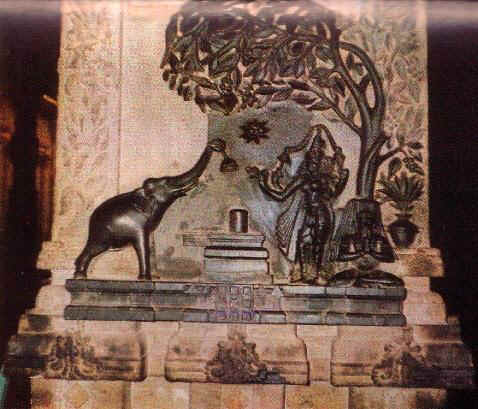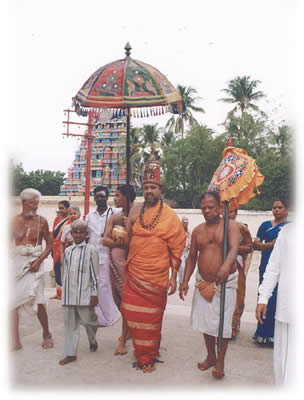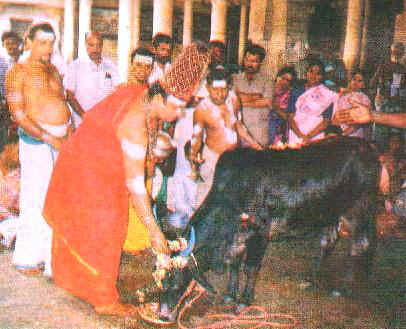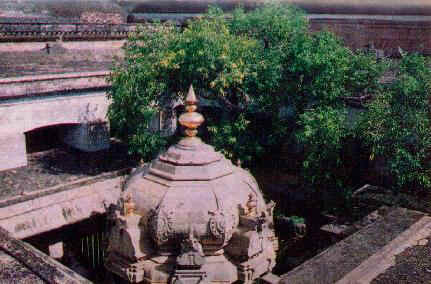
The Formation of 'Appu Lingam' (Parvathi’s Penance):
Once Devi Parvati mocked at Lord Shiva’s penance for betterment of the World. Lord Shiva wanted to condemn her act and directed her to go to the earth from 'Kailayam' and do penance. Devi Parvathi (Akilandeswari) as per Shiva's wish found 'Jambu' forest (Thiruvanaikoil) to conduct her penance. Devi made a Lingam out of water of river Cauvery (also called as river 'Ponni') under the 'Venn Naaval' tree (the Venn Naaval tree on top of the saint Jambu) and commenced her worship. So, the Lingam is known as 'Appu Lingam' (Water Lingam).
Legend of the temple in a Sculpture in a Pillar in the temple
Lord Siva at last gave darshan to Akilandeswari and taught her Siva Gnana. Devi Parvati took 'Upadesa' (lessons) facing East from Shiva, who stood facing West. So as the temples idols are also installed in the same direction. Such places are known as 'Upadesa Sthalams'. As the Devi was like a student and the Lord like a Guru in this temple, there is no 'Thiru Kalyanam' (marriage) conducted in this temple for Lord & the Devi, unlike the other Shiva temples.
Temple Archakar dressed like Devi Akilandeswari is going in procession to perform Shiva Pooja
As Akilandeswari worshipped Lord Shiva in this temple, even today at noon the 'Archakar' (priest) dresses like a female and does Pooja to Lord Shiva and 'Ko Maatha' (Cow). This noon pooja is very famous and pilgrims wait for this pooja every day. For the purpose of this pooja the temple is growing a 'Karam Pasu' (complete black color cow). Annabhishekam to Lingam (Abishekam with cooked rice) is a daily ritual at Thiruvanaikoil.

Temple Archakar dressed like Devi Akilandeswari performig Ko Poojai
The Legend of the Name - 'Thiru Aanai Kaa'
There were two Siva Ganas (Siva’s disciples who live in Kailash) by name 'Malyavan' and 'Pushpadanta'. Though they are Shiva Ganas they always quarrel with each other and fight for one thing or other. On top of all in one fight 'Malyavan' cursed 'Pushpadanta' to become an elephant in earth and the latter cursed the former to become a spider in earth.
Both the elephant and the spider came to Jambukeshwaram and continued their Shiva worship. The elephant collected water from river Cauvery and conducted Abhishekam to the lingam under the Jambu tree daily. The spider constructed his web over the lingam to prevent dry leaves from dropping on it and prevent Sunlight directly felling on Shiva.
When the elephant saw the web and thought that as dust on Lord Shiva and tore them and cleaned the Linga by pouring water. This happened daily. The spider became angry one day and crawled into the trunk of the elephant and bit the elephant to death killing itself. Lord Siva, moved by the deep devotion of the two relieved them from one other curse.
As an elephant worshipped the Lord here, this place came to be known as 'Thiru Aanai Kaa' (Thiru – Holy, Aanai – Elephant, Kaa (Kaadu) – Forest). Later the actual name 'Thiruaanaikaa' become 'Thiruvanaikaval' and 'Thiruvanaikoil'.
In the next birth the Spider was born as the King Ko Chengot Chola and built 70 temples and Thiruvanaikoil is the one among them. Remembering his enmity with the elephant in his previous birth, he built the Lord Shiva 'Sannathi'(Sanctorum) such that not even a small elephant can enter. The entrance on the sanctorum of Lord Shiva is only 4 foot high and 2.5 foot wide.
Jambukeswaram:
Thiruvanaikoil is also called as 'Jambukeswaram' and the Lord as Jambukeswara, Jambunathan and Jambulingam. The myth behind this is, there was a Sage by name 'Jambu Munivar' (munivar – sage). He once got a rare and sacred 'Venn Naaval' (Venn – White, White variety if Naaval fruit) fruit and he offered that fruit to Lord Siva. The Lord after eating the fruit spitted the seed. Jambu Munivar took and swallowed the seed, as it is sacred as the seed came from the Lord’s mouth. Immediately a 'Naaval' tree began to grow in the Saint's head. The Saint prayed to Lord Siva that He should take his abode under that tree. Lord accepted and asked him to continue his penance in the forest on the banks of river Cauvery and said that he will one day come there and abode under that tree. After many years Devi Akilandeswari worshiped Lord Shiva under that tree during her penance. Thus as he took adobe under the tree on Jambu Munivar he was called as 'Jambukeshwara' and the place is called as 'Jambukeshwaram'. Also thus the 'Venn Naaval' became the 'Sthala Vriksham' (Temple’s Sacred tree). The Shiva Lingam is placed under the Venn naaval tree in this temple. Even today you can see that Venn Naaval tree at the temple, which is said to be many hundred years old.

The Vimanam of Lord Shiva Sanctorum and the 'Venn Naaval' tree (which is thousands of years old)